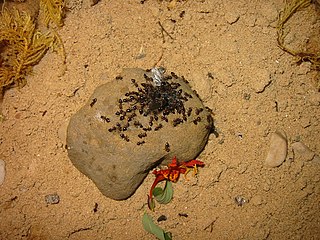
Myrmicinae is a subfamily of ants, with about 140 extant genera; their distribution is cosmopolitan. The pupae lack cocoons. Some species retain a functional sting. The petioles of Myrmicinae consist of two nodes. The nests are permanent and in soil, rotting wood, under stones, or in trees.

Crematogaster is an ecologically diverse genus of ants found worldwide, which are characterised by a distinctive heart-shaped gaster (abdomen), which gives them one of their common names, the Saint Valentine ant. Members of this genus are also known as cocktail ants because of their habit of raising their abdomens when alarmed. Most species are arboreal (tree-dwelling). These ants are sometimes known as acrobat ants.

Crematogastrini is a tribe of myrmicine ants with 64 genera and 8 fossil genera.

Joseph Charles Bequaert was an American naturalist of Belgian origin, born 24 May 1886 in Torhout (Belgium) and died on 12 January 1982 in Amherst, Massachusetts.

Carebara diversa is a species of marauder ant widely distributed throughout Asia.

Stigmatomma is a genus of ants in the subfamily Amblyoponinae. The genus has a worldwide distribution, and like most other amblyoponines, Stigmatomma species are specialized predators. First described by Roger (1859), it was for a long time considered to be a synonym of Amblyopone until it was revived as an independent genus by Yoshimura & Fisher (2012) based on worker mandible morphology.

Lepisiota is an Old World genus of ants in the subfamily Formicinae. They nest in rotten wood, in standing trees or in the ground, generally in less forested areas.

Meranoplus is an Old World genus of ants in the subfamily Myrmicinae. With over 80 valid species, it is predicted that over half of the Meranoplus diversity remains undescribed, most of these from Australia.

Crematogaster aberrans is a species of ant in tribe Crematogastrini. It was described by Forel in 1892.
Crematogaster binghamii is a species of ant in tribe Crematogastrini. It was described by Forel in 1904.
Crematogaster buchneri is a species of ant in tribe Crematogastrini. It was described by Forel in 1894.
Crematogaster buddhae is a species of ant in tribe Crematogastrini. It was described by Forel in 1902. It is found across South and South-East Asia.
Crematogaster clydia is a species of ant in tribe Crematogastrini. It was described by Forel in 1912.
Crematogaster dohrni, is a species of ant of the subfamily Myrmicinae, which is a widespread species that can be found from Sri Lanka, India, Indonesia, Thailand, and China.

Crematogaster rogenhoferi is a species of ant of the subfamily Myrmicinae that can be found in Sri Lanka.

Crematogaster torosa is a species of ant in the family Formicidae.









